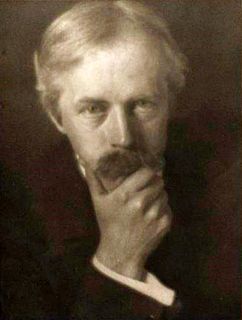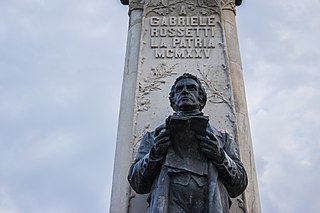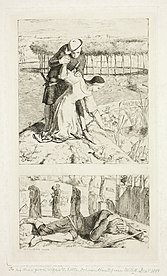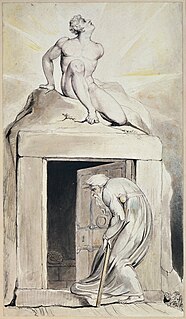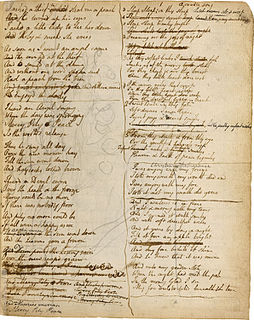 cover for the 1880 edition | |
| Author | Alexander Gilchrist |
|---|---|
| Cover artist | Frederic Shields |
| Country | England |
| Language | English |
| Subject | William Blake |
| Genre | biography |
Publication date | 1863; 1880 |
The Life of William Blake, "Pictor Ignotus." With selections from his poems and other writings is a two-volume work on the English painter and poet William Blake, first published in 1863. The first volume is a biography and the second a compilation of Blake's poetry, prose, artwork and illustrated manuscript.

William Blake was an English poet, painter, and printmaker. Largely unrecognised during his lifetime, Blake is now considered a seminal figure in the history of the poetry and visual arts of the Romantic Age. What he called his prophetic works were said by 20th-century critic Northrop Frye to form "what is in proportion to its merits the least read body of poetry in the English language". His visual artistry led 21st-century critic Jonathan Jones to proclaim him "far and away the greatest artist Britain has ever produced". In 2002, Blake was placed at number 38 in the BBC's poll of the 100 Greatest Britons. While he lived in London his entire life, except for three years spent in Felpham, he produced a diverse and symbolically rich œuvre, which embraced the imagination as "the body of God" or "human existence itself".
Contents
The book was largely written by Alexander Gilchrist, who had spent many years compiling the material and interviewing Blake's surviving friends. However, Gilchrist had left it incomplete at his sudden death from scarlet fever in 1861. The work was published two years later, having been completed by his widow Anne Gilchrist with help from Dante Gabriel Rossetti and William Michael Rossetti.

Alexander Gilchrist, an English author, is known mainly as a biographer of William Etty and of William Blake. Gilchrist's biography of Blake is still a standard reference work about the poet.

Scarlet fever is a disease which can occur as a result of a group A streptococcus infection, also known as Streptococcus pyogenes. The signs and symptoms include a sore throat, fever, headaches, swollen lymph nodes, and a characteristic rash. The rash is red and feels like sandpaper and the tongue may be red and bumpy. It most commonly affects children between five and 15 years of age.
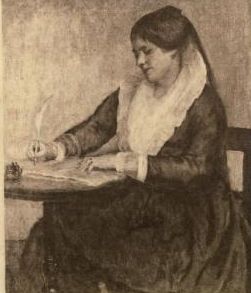
Anne Gilchrist, née Burrows, was an English writer, best known for her connection to American poet Walt Whitman.
The book became the first standard text on the Blake, a foundation of the extensive scholarship on his life and work. The original 1863 edition was subtitled "Pictor Ignotus", Latin for "unknown artist", a common phrase used for unattributed artworks. Here it refers to Blake's obscurity at the time. The phrase was taken from the recently published poem of that title by Robert Browning, part of which was used as an epigraph. [1] A second edition was published in 1880; this included additional material and revisions to the earlier transcripts of Blake's work and Gilchrist's bibliographical details. Both are referred as Gilchrist's Blake or Life.

Robert Browning was an English poet and playwright whose mastery of the dramatic monologue made him one of the foremost Victorian poets. His poems are known for their irony, characterization, dark humour, social commentary, historical settings, and challenging vocabulary and syntax.
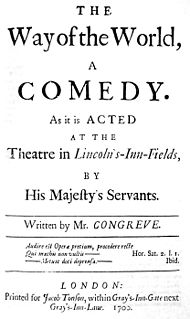
In literature, an epigraph is a phrase, quotation, or poem that is set at the beginning of a document, monograph or section thereof. The epigraph may serve as a preface to the work; as a summary; as a counter-example; or as a link from the work to a wider literary canon, with the purpose of either inviting comparison or to enlisting a conventional context.

Several of Blake's short poems, such as "The Tyger", were typeset during his lifetime and had become widely known since the author's death in 1827, having been reproduced in commonplace books by William Wordsworth and others; however, the larger corpus of his work remained in relative obscurity.
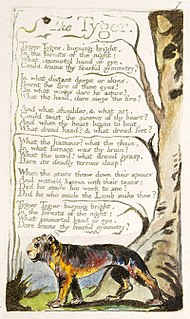
"The Tyger" is a poem by the English poet William Blake published in 1794 as part of the Songs of Experience collection. Literary critic Alfred Kazin calls it "the most famous of his poems", and The Cambridge Companion to William Blake says it is "the most anthologized poem in English". It is one of Blake's most reinterpreted and arranged works.
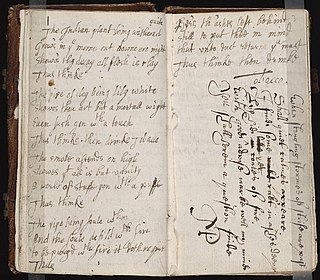
Commonplace books are a way to compile knowledge, usually by writing information into books. They have been kept from antiquity, and were kept particularly during the Renaissance and in the nineteenth century. Such books are essentially scrapbooks filled with items of every kind: recipes, quotes, letters, poems, tables of weights and measures, proverbs, prayers, legal formulas. Commonplaces are used by readers, writers, students, and scholars as an aid for remembering useful concepts or facts. Each one is unique to its creator's particular interests but they almost always include passages found in other texts, sometimes accompanied by the compiler's responses. They became significant in Early Modern Europe.

William Wordsworth was an English Romantic poet who, with Samuel Taylor Coleridge, helped to launch the Romantic Age in English literature with their joint publication Lyrical Ballads (1798).
The second volume, edited and annotated by Dante Gabriel Rossetti, included most of Blake's songs, verse and other poetry, his prose, and letters. These were often the first publication in typeset. The editors sometimes adapted the works during transcription, printing "Tyger" as "Tiger" for the well known example, and largely excluded discussion and republication of the 'Prophetic Books'. The transcriptions included the Poetical Sketches (selections), the Songs of Innocence and of Experience , the Book of Thel , and unpublished poetry from manuscript as "Ideas of Good and Evil". Prose works include the rare Descriptive Catalogue , Blake's description of the paintings exhibited at his solo exhibition in 1809. It includes his analysis of Chaucer's The Canterbury Tales , and an account of his panoramic depiction of the pilgrims leaving London.

Poetical Sketches is the first collection of poetry and prose by William Blake, written between 1769 and 1777. Forty copies were printed in 1783 with the help of Blake's friends, the artist John Flaxman and the Reverend Anthony Stephen Mathew, at the request of his wife Harriet Mathew. The book was never published for the public, with copies instead given as gifts to friends of the author and other interested parties. Of the forty copies, fourteen were accounted for at the time of Geoffrey Keynes' census in 1921. A further eight copies had been discovered by the time of Keynes' The Complete Writings of William Blake in 1957. In March 2011, a previously unrecorded copy was sold at auction in London for £72,000.

Songs of Innocence and of Experience is an illustrated collection of poems by William Blake. It appeared in two phases. A few first copies were printed and illuminated by William Blake himself in 1789; five years later he bound these poems with a set of new poems in a volume titled Songs of Innocence and of Experience Shewing the Two Contrary States of the Human Soul. William Blake was also a painter before the songs of innocence and experience and made paintings such as Oberon, Titania, and Puck dancing with fairies.
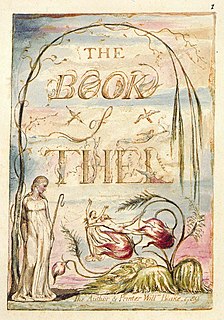
The Book of Thel is a poem by William Blake, dated 1789 and probably composed in the period 1788 to 1790. It is illustrated by his own plates, and compared to his later prophetic books is relatively short and easier to understand. The metre is a fourteen-syllable line. It was preceded by Tiriel, which Blake left in manuscript. A few lines from Tiriel were incorporated into The Book of Thel. Most of the poem is in unrhymed verse.
The work reproduced many of Blake's illustrations from public and private collections, interspersed throughout the biography and series of plates from his illuminated books. Many of these were engraved by William James Linton. Other designs, commentary and the second edition's cover were provided by Frederic Shields.
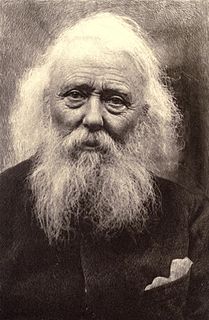
William James Linton was an English-born American wood-engraver, landscape painter, political reformer and author of memoirs, novels, poetry and non-fiction.

Frederic James Shields was a British artist, illustrator and designer closely associated with the Pre-Raphaelites through Dante Gabriel Rossetti and Ford Madox Brown.
Anne Gilchrist appended a memoir of her husband, Alexander, to the second volume.
A review by James Smetham of the first edition was included in the second as an "Essay on Blake". The biography of the second edition was expanded with Blake's letters, obtained in an 1878 sale at Sothebys.


